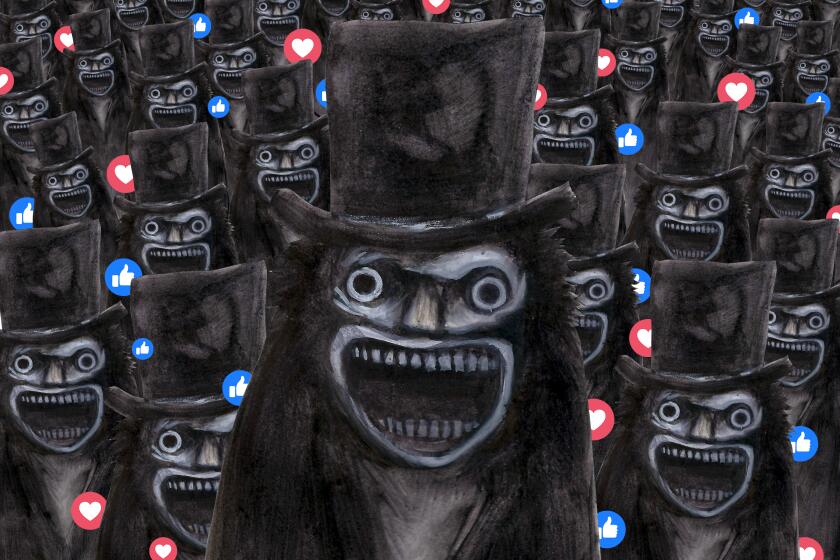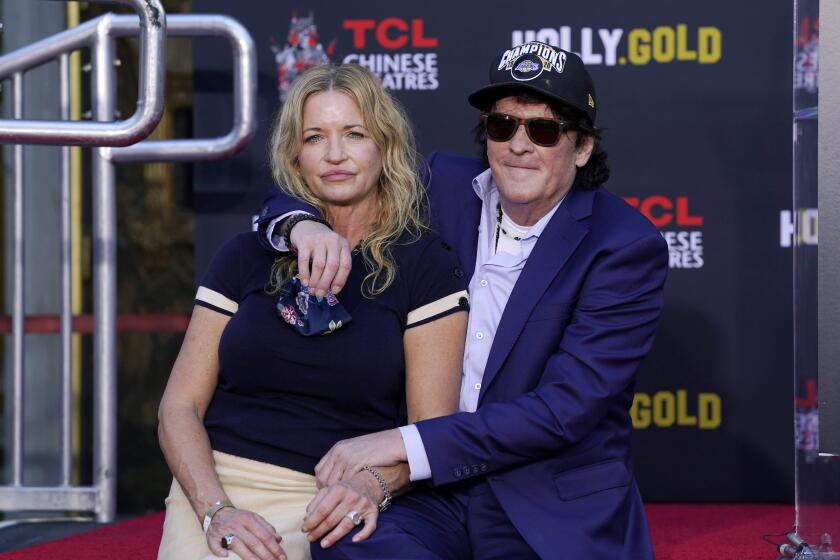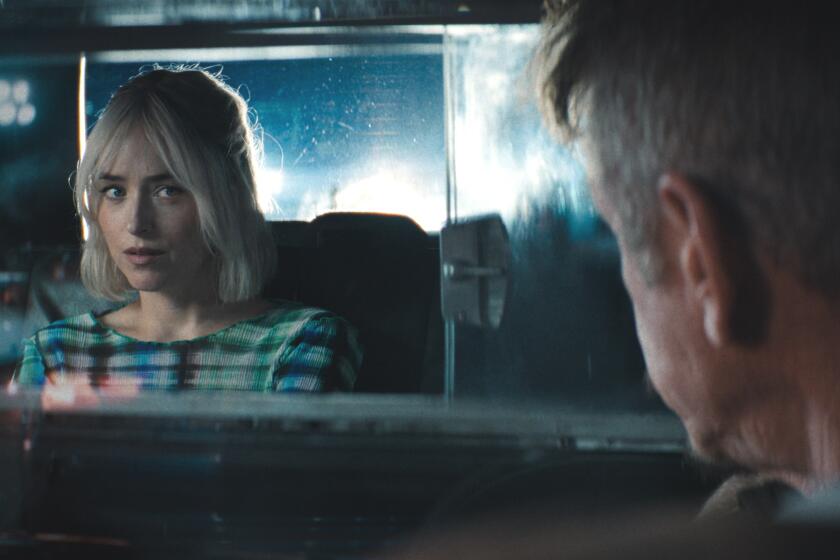Thirst blood
The posters for “Rambo” that have been proliferating like kudzu across the urban landscape feature a blurry black-and-white rendering of our hero’s iconic mug. It’s a pop abstraction -- part Che Guevara, part Jesus, part FBI’s “Ten Most Wanted” list. The posters are telling us: He’s back and, boy, do we ever need him.
This Rambo Redux makes sense in a post-9/11 world where nobody in Hollywood seems willing to invent new-style heroes to match up with new-style villains. The Iraq-themed movies, in particular, have been conspicuously, even necessarily, anti-heroic. Enter John J. Rambo. Officially, he is not fighting Al Qaeda -- he’s embroiled upriver in the Burmese civil war rescuing medical missionaries. But we all know who the Burmese are standing in for. (By the way, did nobody tell the filmmakers that Burma is now called Myanmar -- or is “Myanmar” too much of a mouthful for Rambo?)
I’m not surprised that Sylvester Stallone revived Rambo. Like the “Rocky” series, the “Rambo” franchise, which has huge global appeal, is his annuity. But I was initially puzzled about who the audience for this film would be. It’s tough enough getting boomers out of the house to see anything these days, let alone another movie about a galoot with a bowie knife as big as the Ritz. And their children? Without any emotional connection to Stallone or any firsthand memories of Vietnam, wouldn’t they be even less likely to bite?
The lads whoop it up
As it turns out, no. The film did respectable business in its first weekend -- half the audience was younger than 25, two-thirds was male -- and there is talk now of a fifth “Rambo.” (Stallone also wants to revive the “Death Wish” franchise. Oy.)
I saw the film on its opening night in a mostly filled theater where every splatter was greeted with whoops. This R-rated “Rambo” is almost obscenely graphic. (Memo to the MPAA ratings board: Exactly how violent does a movie from a reputable distributor have to be to get slapped with an NC-17?) Stallone opens his pulp fantasia with actual documentary footage of Burmese corpses, which is a bit like asking for butter on your popcorn and getting blood instead. Soon Rambo arrives and we get all too realistically staged shots of exploding heads, limbs, bellies. Whenever his scowl hit the screen, the audience went wild, knowing that carnage could not be very far away. (If Stallone and Mel Gibson ever decide to collaborate on something, send in the clowns.)
The audiences lapping up this stuff aren’t ghouls -- they fell silent, for example, when the real-life atrocity footage came on. They’re simply reacting to the film as a species of video game, and their rebel yells feel more honest than the “serious” political overlay Stallone periodically injects into the mayhem. “He’s a beast,” one admiring twentysomething viewer told me afterward, adding that he liked Rambo because as a kid he saw the earlier installments with his father. It’s all about bonding.
Could Rambo be the Tony Bennett of the new movie generation? His retro-ness has become his pedigree. Of course, in both his Rocky and Rambo incarnations, Stallone has always been blatantly retro. The “Rocky” movies draw heavily on Depression-era tropes; the “Rambo” narratives are positively primeval. (With his no-tech skills and half-Indian blood, Rambo is as elemental as Tarzan, if not as talkative.)
Unlike other aging stars (such as Bruce Willis) attempting to revive their action franchises, Stallone, in “Rambo,” doesn’t try to tamp down the toll of the years. (He didn’t in “Rocky Balboa” either, which accounted for its sweetness and may have been the key to its commercial success.) Stallone is a bit like the latter-day John Wayne, who also put his gruff weariness on display. But Wayne, in films such as “Rooster Cogburn,” consciously cartoonized his own image, while Stallone in his Rambo mode is still playing it straight. And this squareness may be one reason why his audience still finds him authentic -- a classic.
But the Rambo character, who was originally conceived at a time when Hollywood was cuckoo for Joseph Campbell, has always been surprisingly shape-shifty. His myth mutates with the times. The novelist David Morrell, who created the Rambo character, once described his game plan: “Take some hippie off the street and make him the fastest gun in the West.” In 1982’s “First Blood,” John Rambo, the long-haired drifter and Congressional Medal of Honor winner, is harassed by the local cops and proceeds to tear up half of the Pacific Northwest. Cornered at the end, he wails against the ingrates who welcomed him back from Vietnam with cries of “baby killer.” You’ve got to hand it to Stallone: He co-opted the peacenik hippie martyrdom of films like “Easy Rider” even as he trashed it.
In 1985’s “Rambo: First Blood Part II,” he is sent on a recon mission to locate American POWs in Vietnam -- which plays out as a symbolic redo of the war -- and asks, “Do we get to win this time?” His special ire is reserved not for the Viet Cong he encounters (they run like ninnies) or their Russian overlords (funny accents). The real enemies are the bureaucratic stooges in Washington who still don’t want him to win. This time his closing wail is “All I want is for my country to love me as much as I love it.”
The next installment, 1988’s “Rambo III,” has our man living as a handyman in a Thai monastery, except for the occasional out-of-town smackdown, when the call comes to once again go up against the Russkies, this time in Afghanistan. (Rambo is nothing if not a Cold Warrior.) Stampeding through an orgy of explosions, Rambo has ample time to display his scarred torso: his stigmata. His captured mentor, Richard Crenna’s Col. Sam Trautman, berates the Soviets for fighting a war with a people who would “rather die than be slaves to a defeating army.” Mujahedin and Viet Cong -- soul mates.
Fighter, not a lover
Twenty years later, in “Rambo,” the truth is out. Speaking to himself and to a band of mercenaries, he says, “You didn’t kill for your country, you killed for yourself.” For Stallone, being true to your essence is everything. The message of “Rocky Balboa” was: “Fighters fight.” That’s also the message of “Rambo.” With his uncanny instinct for riding the zeitgeist, Stallone may have lucked out yet again.
“War is in your blood” is Rambo’s rallying cry. In a terrorized modern world where the battle lines are constantly being redrawn or can’t even be found -- where the tortured and the torturers are sometimes interchangeable -- Rambo’s meathead existentialism at least has the ring of a convenient truth. Fighters fight. And aging action icons make sequels. Maybe in the next go-round Rambo and Rocky can team up to save the world. Suggested title: “Apocalypse Yo.”
--
Peter Rainer is film critic for the Christian Science Monitor and DVD critic for Bloomberg News.
More to Read
Only good movies
Get the Indie Focus newsletter, Mark Olsen's weekly guide to the world of cinema.
You may occasionally receive promotional content from the Los Angeles Times.









